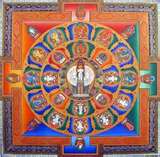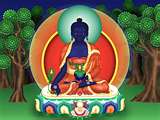 When it comes to health and healing, I choose to put myself in situations that push the limits of the rational mind. Growth comes from taking ourselves to the edge of our comfort zone, both mentally and physically. Since I alway get sick when I go to India and Nepal, I'm given a great chance to be the patient and see what works. So when I heard some other travelers talking about going to see the Tibetan sucking lady, I didn't hesitate to tag along.
When it comes to health and healing, I choose to put myself in situations that push the limits of the rational mind. Growth comes from taking ourselves to the edge of our comfort zone, both mentally and physically. Since I alway get sick when I go to India and Nepal, I'm given a great chance to be the patient and see what works. So when I heard some other travelers talking about going to see the Tibetan sucking lady, I didn't hesitate to tag along.
The first time I went to Nepal was in 1995. I was there to pursue my studies of Ayurveda in India as well as Nepal. Not long after I arrived in Kathmandu, the pollution spewed out by the millions of tuk-tuks, aka rickshaws, finally got to me. I started wheezing and coughing, and substantially lost my energy. I had suffered from asthma before I became a student of Ayurveda and completely transformed my diet, herbal regimen, and lifestyle. In Kathmandu I felt like I was back at square one. I saw an Ayurvedic physician, a Tibetan doctor, and a homeopath, all with minimal results.
One day I overheard some other travelers in our guesthouse near the Boudnath Stupa talking about plans to visit the "Tibetan sucking lady." Instinctively, I knew I had to join them, so I inquired and invited myself along. I was somewhat familiar with the shamanic practice of "sucking" that is common to many shamanic cultures around the world. It is a form of psychic surgery, and can be performed by a shaman using their mouth, their hands, or another implement of some kind. It is practiced around the world, from South America to Asia. I had no idea exactly what was in store, but I was so sick that I was willing to try anything.
 A Dutch translator accompanied a group of us Westerners to a nondescript flat a block away from the Stupa gates. We were welcomed by a very sweet Tibetan woman and her friendly husband. He served tea while the living room filled with Nepali, Indian and Tibetan patients. The woman was busy arranging things at the Buddhist altar, which looked like the ones I'd seen in other Tibetan homes. I might not have noticed anything different about what she was doing, until she put on a multi-colored headdress and special accoutrements like a costume of some kind. She began her prostrations to the altar, and that's when the energy shift in the room became palpable. The woman's eyes rolled toward the back of her head, and she seemed to grow about two feet. She began to stomp around the room making bold, violent gestures and emitting loud grunting noises.
A Dutch translator accompanied a group of us Westerners to a nondescript flat a block away from the Stupa gates. We were welcomed by a very sweet Tibetan woman and her friendly husband. He served tea while the living room filled with Nepali, Indian and Tibetan patients. The woman was busy arranging things at the Buddhist altar, which looked like the ones I'd seen in other Tibetan homes. I might not have noticed anything different about what she was doing, until she put on a multi-colored headdress and special accoutrements like a costume of some kind. She began her prostrations to the altar, and that's when the energy shift in the room became palpable. The woman's eyes rolled toward the back of her head, and she seemed to grow about two feet. She began to stomp around the room making bold, violent gestures and emitting loud grunting noises.
I still wasn't exactly afraid, just curious. She finally sat down and called upon a young Nepali gentleman to come up first. Surprisingly, she took his pulses, as a Tibetan or Ayurvedic doctor customarily does. She asked him a few questions and made some comments and prescriptions. Then, brandishing a ritual dagger called a phurba, she began to pound on his back with it, while chanting and singing. Her husband handed her a silver straw-like implement and she plunged it into the left side of his low back. He arched with pain and screamed in horror. Now I was scared. She spit with great force into a copper vessel that her husband held out to her, and then ordered him to pass it around for the group of us to examine. In the cup was a small stone about the size of a fennel seed. The translator announced that it was a kidney stone.
I was called up next. She took one look at me and I began to wail. I didn't know why, other than that I was petrified, and I usually have that reaction in the presence of supernatural phenomena. She took my pulses and, through the translator, told me that I had holes in my lungs, and that I should never sleep naked. She shouted a prescription for Tibetan medicines to someone taking notes, and then pulled out the phurba. She pounded on my back, and although it wasn't extremely painful, I cried even more. Then she spun me around and lunged at the center of my chest with her mouth open wide. The sensation of her sucking on my skin was like a really strong hickey. The vacuum effect was incredible and torturous, but only briefly. Then she spit a dark, black, tar-like substance into her copper cup. She sucked again in several places on my upper chest, and each time spit out more tar. At one point I looked down at my skin to see what was happening, and was amazed to see droplets of that black tar oozing out of the pores of my skin. Then she was done, and I was shooed away back to my spot in the audience, while everyone examined the contents of the copper cup.
It took me a while to calm down, from the pain and the excitement of it all. She treated dozens more people this way, spitting out old, undigested meat from one woman's gut, more black tar from various parts of other people's bodies, and one or two more kidney stones. When she was finished, we all left donations in a basket as she removed her ritual outfit and returned to her normal self. We were given small bags of barley that had been on the altar and were energized by the healing. We were told to either return for a follow-up treatment or to leave an item of our clothing for her to work on a few days later. We were also warned not to exert ourselves right away, since we were recovering from surgery.
Once I had regained my composure, I was aware that I did, in fact, feel very different. I had a much greater breathing capacity, I was no longer wheezing, and I felt more vitality than I'd felt in a month. When I did go hiking the following day, up to Kopan monastery above Boudha, I had no trouble breathing at all. I took the Tibetan medicines prescribed for me and enjoyed a drastic improvement in my health for quite some time. My travel plans changed so I was not able to go for my follow-up treatment. My asthma symptoms did return do a mild degree, but the power of the experience remained.
Years later I was in the grocery store, when I stopped dead in my tracks in front of the magazine rack. On the cover of Shaman's Drum was the Tibetan sucking lady! I couldn't believe it, and I promptly bought the magazine. From reading the article, I finally learned the woman's name and her story. It turns out the author of the article had met and observed "Mrs. Dolkar" the year after I had and was so intrigued he decided to research her history and publish her story.
Mrs. Dolkar is also known by the spiritual title of Lhamo. "A lhamo is a type of traditional Tibetan oracle who can temporarily embody deities, who enable her to perform shamanic healing and divination work." (Shaman's Drum, number 45) The diety that possesses Mrs. Dolkar is called Dorje Yudronma, and is a pre-Buddhist Tibetan mountain deity that was incorporated into Buddhism as it became established in Tibet. Interestingly enough, H.H. the Dalai Lama officially certified Mrs. Dolkar as a "reliable exorcist" for "all mental and physical ills and problems." (Shaman's Drum, number 45)
In the Tibetan tradition, oracles are usually born into a family of shamans. Mrs. Dolkar was not, and therefore her family did not understand why, at an early age, she suffered illness and psychotic episodes. She became a Buddhist nun at age 13 and was known as the "Crazy Nun" because of her unpredictable behavior. She left the nunnery at the insistence of a mysterious old woman who visited her in her dreams. Eventually she married and went to India, but was still unstable and moving from place to place. It was while she was living in Ladakh that a high lama recognized her shamanic potential. Another Lhamo perceived that Mrs. Dolkar had been chosen by the Goddess Dorje Yudronma because of their connection in a previous life. Mrs. Dolkar remained with this Abhi Lhamo as her guru to heal and to learn how to channel the Goddess's energy.
 Mrs. Dolkar was actually invited by the Dalai Lama to visit him in Dharamsala, India. He officially recognized her as an embodiment of the healing goddess and was said to have instructed Dorje Yudronma to be less wrathful and less violent. So evidently the methods I witnessed during my healing session were quite a bit more subdued than they had once been. Dorje Yudronma may be considered a wrathful deity because of the aggressive nature of her healing methods, yet her ultimate purpose, like that of all Buddhist deities, is to work toward relieving the suffering of all sentient beings.
Mrs. Dolkar was actually invited by the Dalai Lama to visit him in Dharamsala, India. He officially recognized her as an embodiment of the healing goddess and was said to have instructed Dorje Yudronma to be less wrathful and less violent. So evidently the methods I witnessed during my healing session were quite a bit more subdued than they had once been. Dorje Yudronma may be considered a wrathful deity because of the aggressive nature of her healing methods, yet her ultimate purpose, like that of all Buddhist deities, is to work toward relieving the suffering of all sentient beings.
There is no scientific explanation for how Mrs. Dolkar is able to extract substances and diseases through the skin, although I saw it with my own eyes. People may want to discount the whole thing as an optical illusion. Yet phenomena exist throughout the world that defy logic and the laws of time and space. Bearing witness to such ritual warps our sense of what is real and what is illusion. We cannot help but be awakened to the awesome potential that exists for shamans and laypeople alike. Experiences like this can serve to remind us that not only is anything possible, but that miracles are occurring all around us on a daily basis, if only we have the perspective to see them in that light.
